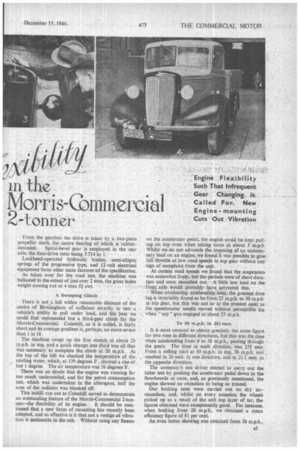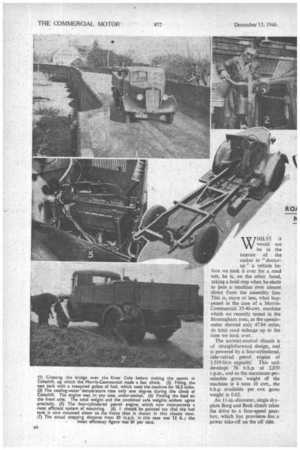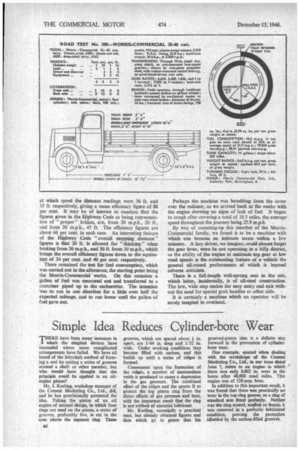in the Morri s-COITIMei )ei al 2-tonner
Page 39

Page 38

Page 40

If you've noticed an error in this article please click here to report it so we can fix it.
WHILST it would not be in the interest of the
maker to " doctorup " a vehicle be . fore we took it over for a road test, he is, on the other hand, taking a bold step when he elects to pass a machine over almost direct from the assembly line.
This is, more or less, what happened in the case of a Morris Commercial 35-40-cwt. machine which we recently tested in the Birmingham area, as the speedo meter showed only 47.04 miles, its total road mileage up to the time we took over.
The normal-control chassis is of straightforward design, and is powered by a four-cylindered, side-valved petrol engine of 3.519-litre capacity. This unit
develops 56 b.h.p. at 2,850
r.p.m., and as the maximum permissible gross weight of the machine is 4 tons 10 cwt., the b.h.p. available per cwt. gross weight is 0.62.
An 11-in.-diameter, single dryplate Borg and Beck clutch takes the drive to a four-speed gearbox, which has provision for a power take-off on the off side. From the gearbox the drive is taken by a two-piece propeller shaft, the centre bearing of which is rubber mounted. Spiral-bevel gear is employed in the rear axle, the final-drive ratio being 5.714 to 1.
Lockheed-operated hydraulic brakes, semi-elliptic springs of the progressive type, and 12-volt electrical equipment form other main features of the specification.
As taken over for the road test, the machine was ballasted to the extent of just over 2 tons, the gross laden weight coming out at 4 tons 5:7 cwt.
A Sweeping Climb There is iota hill within reasonable distance of the centre of Birmingham of sufficient severity to test a vehicle's ability to pull under load, and the best we could find represented but a third-gear climb for the Morris-Commercial. Coleshill, as it is called, is fairly short and its average gradient is, perhaps, no more severe than 1 in 18.
The machine swept up the first stretch at about 28 m.p.h. in top, and a quick change into third was all that was necessary to complete the climb at 20 m.p.h. At the top of the hill we checked the temperature of the cooling water, which, at 139 degrees F, showed a rise of but I degree. The air temperature was 56 degrees.E.
There was no doubt that the engine was running far too much undercooled, and for the petrol consumption test, which was undertaken in the afternoon, half the area of the radiator was blanked off.
This initi6.1 run out to Coleshill served to demonstrate an outstanding feature of the Morris-Commercial 2-tonner—the flexibility of its engine. It should be mentioned that a new form of mounting has recently been adopted, and so effective is it that not a vestige of vibration is noticeable in the cab. Without using any finesse
on the accelerator pedal, the engine could be kept pulling • on top even when taking turns at about 5 m.p.h. Whilst we do not advocate the imposing of an unnecessary load on an engine, we found it was possible to give full throttle at low-road speeds in top gear without any
sign of complaint from the unit. .
At certain road speeds we found that the suspension was somewhat lively, but the periods were of short duration and soon cancelled out. .Alittle less load on the _front axle wouldprobably: have corrected this. When conducting acceleration tests, the greatest time lag is invariably, found to be from 25 m.p.h. to 30 m.p.h. in top gear, but this Was not so in the present case; as the speedometer needle moved without perceptible lag when " top " was engaged at about 25 m.p.h.
To 30 m.p.h. in 25i secs.
It is most unusual to obtain precisely the same figure for two runs in different directions, but this was the case when accelerating from 0 to30 m.p.h., passing through the gears. The time in each direction Was 251 secs. From a rolling start at 10 m.p.h in top, 30 m.p.h. was reached in 26 secs, in one direction,and in 21.1 secs, in
the opposite direction. .
The company's test driver elected to carry out the latter test by pushing the accelerator pedal down to the' floorboards at once, and, as previously mentioned, the engine showed no objection to being so treated.
Our braking tests were carried out on dry tarmacadam, and, whilst on every occasion the wheels picked up as a result of the soft top layer of tar, the tigures obtained were exceptionally good. For instance, when braking from 20 m.p.h., we obtained a mean efficiency figure of 81 per cent.
An even better showing was obtained from 30 m.p.h., at which speed the distance readings were 36 ft. and 33 ft. respectively, giving a mean efficiency figure of Kt per cent. It may be of interest to mention that the figures given in the Highway Code as being representative of " proper " brakes, are, from 20 m.p.h., 20 ft, and from 30 m.p.h., 45 ft. The efficiency figures are about 66 per cent. in each case. An interesting feature of the Highway Code "overall stopping distance" figures is that 20 ft. is allowed for " thinking " when braking from 20 m.p.h., and 30 ft. from 30 m.p.h., which brings the overall efficiency figures down to the equivalent of 34 per cent. and 40 per cent. respectively.
There remained the test for fuel consumption, which was carried out in the afternoon, the starting point being the Morris-Commercial works. On this occasion a gallon of fuel was measured out and transferred to a container piped up to the carburetter. The intention was to run in one direction for a little over half the expected mileage, and to run home until the gallon of fuel gave out. Perhaps the machine was benefiting from the cover over the radiator, as we arrived back at the works with the engine showing no signs of lack of fuel. It began to cough after covering a total of 18.5 miles, the average speed throughout the journey being 2.5.9 m.p.h.
By way of summing-up this member of the MorrisCommercial family, we found it to be a machine with which one became on intimate terms within a few minutes. A lazy driver, we imagine, could almost forget the gear lever, were he not operating in a hilly district, as the ability of the engine to maintain top gear at low road speeds is the outstanding feature of a vehicle the general all-round performance of which is beyond adverse criticism.
There is a full-length well-sprung seat in the cab, which latter, incidentally, is of all-steel construction. The low, wide step makes for easy entry and exit without the need for special grab handles or other aids.
It is certainly a machine which an operator will be sorely tempted to overload.












































































